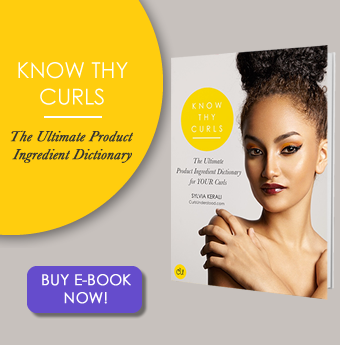
Below are five things we think you should determine ASAP to help your natural hair journey be a little smoother (also check out our Glossary):
Understand your hair’s attributes and what that means for you
Your first mission, should you choose to accept it, will be determining your hair’s attributes (Texture, Volume, Length, Porosity, Width). Just looking at your hair won’t cut it. To really know what you’re working with you’ll need to experiment with your hair for at least 3 months.
That means styling your hair wet then another time dry to see what it prefers. Experimenting with different products (give each one at least 3 months). Establishing a hair care regimen etc. Also examine your hair when it’s wet and free from product. That’ll give you better insight into what your true texture(s) is.
Those early in their natural hair journey may find it especially useful to seek guidance from naturals with hair attributes similar to theirs. It can save a lot of time, and dollar, dollar bills, avoiding hair products and hairstyles that just weren’t made for their tresses. For each of the Textures listed on this site, we suggest 5 naturals to follow on YouTube. What better way to learn then from other’s mistakes and successes?
Establish a regular hair care regimen that works for your lifestyle
There is no one regimen that works for everyone. Let’s just put it out there. But in the beginning it’s helpful to get some guidance on where to start.
We suggest buying a shampoo, conditioner and leave-in conditioner from the same product line. They’re made to work together so while you’re still in the discovery phase, take advantage of a cohesive system. You can branch out later. Next find a deep conditioner, water-based moisturizer and a natural oil (to seal that moisture in).
Start by washing your hair at least once a week. The conditioner detangles and restores moisture after your shampoo has stripped your hair clean. Use your leave-in conditioner whenever you feel your hair needs moisture or even to style. Leave-in conditioners are usually water-based so it could double up as your water-based moisturizer.
Deep condition at least every other week in the Summer and every week in the Winter – again you can adjust this routine once you learn what your hair needs. Natural oils seal in moisture. So you can either spritz your hair with water or said water-based moisturizer as needed then lightly coat your hair with an oil to lock that moisture/water in. Butters and gels are optional styling products but note the more you use them the more often you’ll probably have to wash your hair.
With time you’ll adjust this basic routine to suit your schedule and hair care needs. Some women wash every 3 weeks. Others deep condition once a month. It really is an individual preference! The key is to pay attention and observe what your hair likes. Does it feel rough, dry, fragile? Is it limp or breaking? If so, it’s time to read up on what the issue is a change your routine accordingly. :)
Find protective styles that you actually like
Think of a protective style as a vacation for your hair. When in protective style mode your hair is free from the everyday manipulation you subject your hair to. While some manipulation is necessary (washing and detangling) other types of manipulation just wear your hair down over time.
We at Curls Understood™ understand that you want to look your best. Just learn the tricks to keep styling manipulation to a minimum. Enter protective styles – defined as a hairstyle that protects the ends of your hair from breaking by limiting its exposure to harsh elements like the weather. The ends of your hair are the oldest and most susceptible to damage. Protecting your ends = retained length.
Some better known protective styles are two-strand twists, braid extensions or cornrows. But up-dos, wigs and weaves also work. Those with thinner/finer hair may prefer the up-dos vs. the two strand twists. Those with shorter hair may want to try wigs.
Protective styles are most effective when worn for many days, or even weeks, at a time. Visit our Hairstyles section for ideas.
Exercise, water and vitamins – three words to live by
Your overall health contributes to the health of your hair… naturally! So making sure your body is getting the right nutrients and exercise is key to growing healthy hair.
Exercise helps to promote blood circulation to the scalp and hair follicles. With regular exercise, at least 3 times a week, hair follicles are nourished by oxygen-rich blood flow. This ultimately increases hair growth. Yay to that!
Water is the ultimate moisturizer. It gives your hair its elasticity thus preventing it from snapping/breaking. Aim to drink 8-10 cups of water a day. It’ll keep your hair and scalp hydrated.
As much as we like to think we eat and drink the right things our diets are not always going to contain the perfect balance of nutrients. Vitamins fill in the gaps. There are a multitude of vitamins to choose from, each with their own unique benefits. For now pick a multi-vitamin like Hairfinity. As you become more well-versed in your hair you can pick a combination that addresses your specific needs.
Your hair is a direct reflection of what you do and put in your body. Take care of yourself and your hair will thrive.
Invest in quality tools
An artist is only as good as her tools. Invest in quality and you’ll be reaping the benefits. We suggest spending a little more on the following tools:
• Shears/Scissors – cut your hair with cheap or blunt scissors and it’ll leave jagged ends which ultimately lead to split ends. Remember that your hair’s ends are older and more fragile. Quality scissors leave ends clean and sharp.
• Wide tooth comb – better quality combs are made of better quality materials and last longer. While some people also use brushes when detangling, the wide tooth comb is a staple and worth investing in.
• Bobby pins – if you buy cheap dollar store bobby pins, you’ll pay for it in the long run. Cheaper pins tend to peel leaving sharp surfaces that snag your hair. Quality pins stay smooth and last longer which means their kinder to your hair.
• Silk scarf – a night wrap or scarf is every black girl’s best friend. While investing in real silk may sound like a luxury, over time real silk will stand the test of multiple washes and thus remain smooth and, well, silky.
And remember if you must use heat to straighten or style invest in a ceramic flat iron. It’s a little kinder to your curls.
Further Reading
Reading is fundamental
Crazy. Sexy. Curls: Sign up for our Newsletter for tips and tricks in your inbox
Consider signing up for our My Curls Understood subscription box to discover your staple products
Transitioning 101
Preparing Others For Your Big Chop
Transitioning With The Help Of A Stylist
Feeling Comfortable After The Big Chop
5 Tips To Deal With Negative Comments About Your Curls
5 Hair Tips For Transtioners
The Newly Natural’s Guide To Night Time Care
*Photo Credits: Brooklyn Magazine and Hannan Saleh



